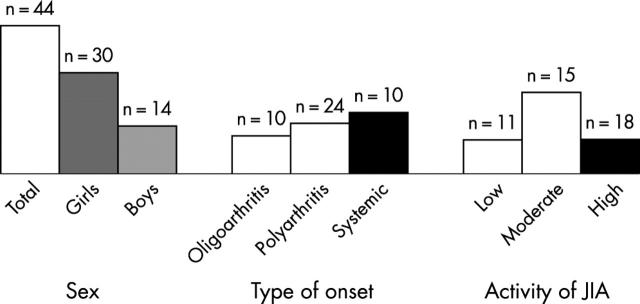Abstract
Objective: To evaluate different aspects of apoptosis in children with juvenile idiopathic arthritis (JIA).
Methods: The frequency of TUNEL positive peripheral blood (PB) lymphocytes (apoptotic index (AI)), as well as serum CD95 (APO1/Fas) antigen expression and serum levels of sFas and interleukin 15 (IL15), were examined in 44 cases of JIA. Results were correlated with type of onset, activity of JIA, and acute phase indicators.
Results: The AI of lymphocytes was significantly higher in patients with JIA than in controls (p=0.020). The mean AI of lymphocytes was increased in JIA with systemic type of onset and high activity (p=0.001). Moreover, IL15 levels in systemic disease were higher than in controls (p=0.012). An increased AI correlated with raised IL15 (p=0.046), erythrocyte sedimentation rate (p=0.005) and C reactive protein (CRP; p=0.017). Additionally, correlation was found between IL15 and CRP levels (p=0.039). CD95 and sFas levels were unchanged compared with controls.
Conclusion: PB lymphocytes of children with JIA have an increased tendency to undergo apoptosis. The degree of apoptosis depends on the type of onset and activity of JIA and correlates with serum levels of IL15. Further studies are needed to explain whether this is an epiphenomenon of the disease activity or is related to the pathogenesis of JIA.
Full Text
The Full Text of this article is available as a PDF (103.3 KB).
Figure 1.
Clinical characteristics of children with JIA. Three subgroups with different onset of disease were established: polyarthritis, oligoarthritis and systemic disease. Three stages of JIA activity were also distinguished, based on clinical and laboratory criteria: low activity (joint movement limited, without pain or swelling, no extra-articular symptoms, ESR <20 mm/1st h, CRP <10 mg/l); moderate activity (moderate intensity of arthritis, and/or slight temperature, ESR 20–60 mm/1st h, CRP 10–30 mg/l); and high activity (morning stiffness, pain and/or swelling of joints, and/or hepatosplenomegaly, fever, rash, and raised values for laboratory tests ESR >60 mm/1st h, CRP >30 mg/l).



